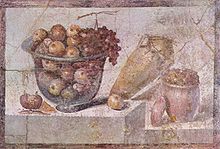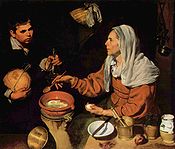
Bodegón
Encyclopedia
The term bodega in Spanish
can mean "pantry", "tavern", or "wine cellar". The derivative term bodegón is an augmentative that refers to a large bodega, usually in a derogatory fashion. In Spanish art
, a bodegón is a still life
painting depicting pantry items, such as victuals, game, and drink, often arranged on a simple stone slab, and also a painting with one or more figures, but significant still life elements, typically set in a kitchen or tavern.
 Starting in the Baroque
Starting in the Baroque
period, such paintings became popular in Spain
in the second quarter of the 17th century. The tradition of still life painting appears to have started and was far more popular in the contemporary Low Countries
, today Belgium
and Netherlands
(then Flemish and Dutch artists), than it ever was in southern Europe. Northern still lifes had many sub-genre's; the breakfast piece was augmented by the trompe-l'œil, the flower bouquet , and the vanitas
. In Spain there were much fewer patrons for this sort of thing, but a type of breakfast piece did become popular, featuring a few objects of food and tableware laid on a table. Though now considered a Spanish invention, the classic trompe-l'œil presentation of fruit on a stone slab was common in ancient Rome
.
 Still life painting in Baroque
Still life painting in Baroque
Spain was often austere; it differed from the Flemish Baroque still lifes, which often contain both rich banquets surrounded by ornate and luxurious items with fabric or glass. In bodegones, the game is often plain dead animals still waiting to be skinned. The fruits and vegetables are uncooked. The backgrounds are bleak or plain wood geometric blocks, often creating a surrealist air. Both Netherlandish and Spanish still lifes often had a moral vanitas
element. Their austerity, akin to the bleakness of some of the Spanish plateaus, never copies the sensual pleasures, plenitude, and luxury of many Northern European still life paintings.
The Velázquez
paintings The Waterseller of Seville
, Old woman frying eggs, and The lunch
are often described as bodegones due to the artist's depiction of jars and foodstuff. Some people reject this use of the term, calling them instead a mixture of genre painting
in Bamboccianti
style and still life
.
Spanish language
Spanish , also known as Castilian , is a Romance language in the Ibero-Romance group that evolved from several languages and dialects in central-northern Iberia around the 9th century and gradually spread with the expansion of the Kingdom of Castile into central and southern Iberia during the...
can mean "pantry", "tavern", or "wine cellar". The derivative term bodegón is an augmentative that refers to a large bodega, usually in a derogatory fashion. In Spanish art
Spanish art
Spanish art is the visual art of Spain, and that of Spanish artists worldwide. Whilst an important contributor to Western art and producing many famous and influential artists Spanish art has often had distinctive characteristics and been assessed...
, a bodegón is a still life
Still life
A still life is a work of art depicting mostly inanimate subject matter, typically commonplace objects which may be either natural or man-made...
painting depicting pantry items, such as victuals, game, and drink, often arranged on a simple stone slab, and also a painting with one or more figures, but significant still life elements, typically set in a kitchen or tavern.
History

Baroque
The Baroque is a period and the style that used exaggerated motion and clear, easily interpreted detail to produce drama, tension, exuberance, and grandeur in sculpture, painting, literature, dance, and music...
period, such paintings became popular in Spain
Spain
Spain , officially the Kingdom of Spain languages]] under the European Charter for Regional or Minority Languages. In each of these, Spain's official name is as follows:;;;;;;), is a country and member state of the European Union located in southwestern Europe on the Iberian Peninsula...
in the second quarter of the 17th century. The tradition of still life painting appears to have started and was far more popular in the contemporary Low Countries
Low Countries
The Low Countries are the historical lands around the low-lying delta of the Rhine, Scheldt, and Meuse rivers, including the modern countries of Belgium, the Netherlands, Luxembourg and parts of northern France and western Germany....
, today Belgium
Belgium
Belgium , officially the Kingdom of Belgium, is a federal state in Western Europe. It is a founding member of the European Union and hosts the EU's headquarters, and those of several other major international organisations such as NATO.Belgium is also a member of, or affiliated to, many...
and Netherlands
Netherlands
The Netherlands is a constituent country of the Kingdom of the Netherlands, located mainly in North-West Europe and with several islands in the Caribbean. Mainland Netherlands borders the North Sea to the north and west, Belgium to the south, and Germany to the east, and shares maritime borders...
(then Flemish and Dutch artists), than it ever was in southern Europe. Northern still lifes had many sub-genre's; the breakfast piece was augmented by the trompe-l'œil, the flower bouquet , and the vanitas
Vanitas
In the arts, vanitas is a type of symbolic work of art especially associated with Northern European still life painting in Flanders and the Netherlands in the 16th and 17th centuries, though also common in other places and periods. The word is Latin, meaning "emptiness" and loosely translated...
. In Spain there were much fewer patrons for this sort of thing, but a type of breakfast piece did become popular, featuring a few objects of food and tableware laid on a table. Though now considered a Spanish invention, the classic trompe-l'œil presentation of fruit on a stone slab was common in ancient Rome
Rome
Rome is the capital of Italy and the country's largest and most populated city and comune, with over 2.7 million residents in . The city is located in the central-western portion of the Italian Peninsula, on the Tiber River within the Lazio region of Italy.Rome's history spans two and a half...
.

Baroque
The Baroque is a period and the style that used exaggerated motion and clear, easily interpreted detail to produce drama, tension, exuberance, and grandeur in sculpture, painting, literature, dance, and music...
Spain was often austere; it differed from the Flemish Baroque still lifes, which often contain both rich banquets surrounded by ornate and luxurious items with fabric or glass. In bodegones, the game is often plain dead animals still waiting to be skinned. The fruits and vegetables are uncooked. The backgrounds are bleak or plain wood geometric blocks, often creating a surrealist air. Both Netherlandish and Spanish still lifes often had a moral vanitas
Vanitas
In the arts, vanitas is a type of symbolic work of art especially associated with Northern European still life painting in Flanders and the Netherlands in the 16th and 17th centuries, though also common in other places and periods. The word is Latin, meaning "emptiness" and loosely translated...
element. Their austerity, akin to the bleakness of some of the Spanish plateaus, never copies the sensual pleasures, plenitude, and luxury of many Northern European still life paintings.
The Velázquez
Diego Velázquez
Diego Rodríguez de Silva y Velázquez was a Spanish painter who was the leading artist in the court of King Philip IV. He was an individualistic artist of the contemporary Baroque period, important as a portrait artist...
paintings The Waterseller of Seville
The Waterseller of Seville (Velázquez)
The Waterseller of Seville is the title of three paintings by Spanish artist Diego Velázquez, dating from 1618-1622. It is widely said to be the greatest of all his Seville paintings.-History:The painting exists in three versions...
, Old woman frying eggs, and The lunch
The Lunch (Velázquez)
The Lunch is a very early painting by Spanish artist Diego Velázquez, finished c. 1617. It is housed in the Hermitage Museum of St. Petersburg.The paintings portrays a table covered by a creased cloth, on which two pomegranates and a piece of bread lies...
are often described as bodegones due to the artist's depiction of jars and foodstuff. Some people reject this use of the term, calling them instead a mixture of genre painting
Genre painting
Genre works, also called genre scenes or genre views, are pictorial representations in any of various media that represent scenes or events from everyday life, such as markets, domestic settings, interiors, parties, inn scenes, and street scenes. Such representations may be realistic, imagined, or...
in Bamboccianti
Bamboccianti
The Bamboccianti were genre painters active in Rome from about 1625 until the end of the seventeenth century. Most were Dutch and Flemish artists who brought existing traditions of depicting peasant subjects from sixteenth-century Netherlandish art with them to Italy, and generally created small...
style and still life
Still life
A still life is a work of art depicting mostly inanimate subject matter, typically commonplace objects which may be either natural or man-made...
.

